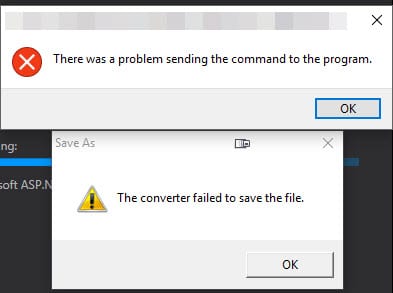How to use Teensyduino to send cmd + enter
Recently we purchased a bunch of Teensyduino powered buttons for a trivia game we were building for a client's convention as a fun learning experience. Now that the conference is through, the buttons are sitting unused, and my boss asked me if I could reprogram one of them so he could use it to send emails through Outlook on Mac. It was a fun little exercise since I've never worked with programming Teensyduinos before. It turned out that this wasn't so complicated to accomplish. I figured I'd share the script in case anyone else would find it useful.
How to Fix ‘Converter Failed to Save File’ with Excel 2016
I recently upgraded to Office 2016 on my Windows 10 desktop and was getting the error "Converter failed to save file" when double clicking on the file along with an "There was a problem sending the command to the program error" every time. I finally had enough with the annoyance to troubleshoot it and figured out a solve. If you have the same issue, here's how to fix it:
One-line snippet to update linux and apps on Ubuntu using apt-get
I find myself using this command on Digitalocean droplets fairly often and am sharing in case anyone else finds it useful. Use this one line to install all updates, security fixes, and system upgrades.
How to test email sending in Laravel 5.3 using artisan tinker
I'm building a Laravel app and ran into an error when trying to send mail but wasn't getting an error back since the request was posted through ajax. If you're trying to troubleshoot it, artisan tinker app is very useful to get more information on the error.
Fire up terminal/command line and run:
ReportCrash High CPU & How to Disable reportcrash in Mac OSX
For a while now, all of my MacBooks have run extremely hot and the fans have gone nuts. While troubleshooting the issue, Activity Monitor showed that an app named reportcrash has run very high on the CPU and has killed my battery life. Force quitting the app didn't help as it would start right back up in a few seconds and climb back to 80-100% usage of the CPU.
How to repair permissions on Linux Apache /var/www/html folder
I recently ran into an issue where I could no longer FTP files to my Linux droplet when multiple users were uploading to the server. The server kept the user as the owner despite me adding them to the www-data group. This fix comes from my ex-boss, James Tomasino who was kind enough to provide some help since I was stumped. I'm sharing in case anyone else runs into the same issue and finds it useful. You'll need to fire up terminal, ssh to the server, and then execute these commands:
Regex to parse date formats when unknown
I'm working on an app that will parse different file sources and aggregate it for a report. Of course, each format has a different date format and trying to parse it all has proved to be a pain. I wrote a regex that'll parse out just about every datetime format I've run into that I am sharing in case someone else finds it useful. I've put it on a Github gist along with a sample of the various dates I've tested it against and confirmed to work. If you find a format not covered by the regex, post a comment and I'll update the gist. Just a note that I haven't finished parsing the timestamp (e.g. 1997-07-16T19:20:30+01:00) format. The date portion does get extracted correctly so I left it in.
(98)Address already in use: AH00072: make_sock: could not bind to address [::]:80 – error
I recently got handed a new Ubuntu droplet at work to setup and work on. I was going through the typical configuration to lock down the server and go to installing Apache when I suddenly ran into the error
How to Copy and Paste into the Digital Ocean VNC Console
I recently signed up for Digital Ocean to test droplets for my development and linux management testing. I was securing the server and setup fail2ban, disabled the root login, and created a user account but forgot to change the user name from root to the user name I selected in my SSH client profile. I ended up locking myself out of the server and had to resort to logging into the admin panel on Digital Ocean's website and use their browser embedded VNC client to restore my access. I quickly discovered that one of the downsides of using this panel is that you can't copy and paste commands. Luckily there's a workaround and you can use the browser console to do sendkeys through Javascript.
Bring up the console in the browser developer tools. Here's a cheat sheet for keyboard shortcuts:

